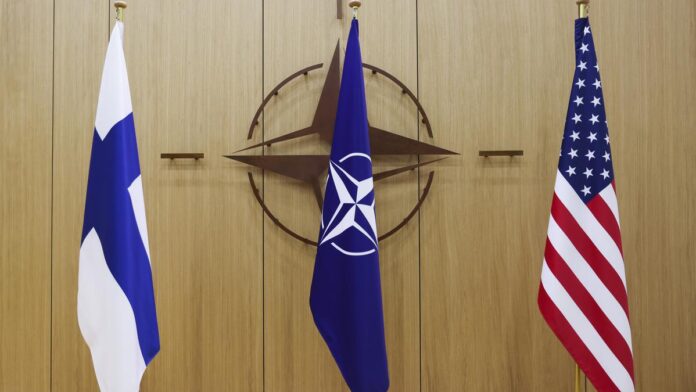On April 4, 2023, Finland joined the North Atlantic Treaty Organization (NATO), becoming its 31st member. Undoubtedly, this is a significant event, given that NATO security guarantees will extend to this country which shares a 1,340 kilometre border with Russia. This historical moment in NATO’s history was full of symbolism, since NATO had clearly scored an additional point against Russia. During the flag-raising ceremony in Brussels, the NATO Secretary-General, Jens Stoltenberg, said, “Finland is safer, and NATO is stronger with Finland as an ally.”
As predicted, Russian authorities have signalled possible ‘countermeasures’ to the alleged ‘assault on its security and national interests’. Though they have blamed NATO for aggravating the tensions, this development must be seen as an independent decision of both Finland and Sweden, triggered largely by the Russia-Ukraine conflict.
Finland is certainly not the first and will not be the last neighbour of Russia to join the alliance. Before Finland’s accession, countries such as Norway (1949, and a founding member), Latvia (2004), Estonia (2004), Poland (1999) and Lithuania (2004) were already a part of NATO. In this scenario, Russia needs to learn how to navigate through these growing complexities, which it is partly responsible for.
Complicated past
For nearly 200 years, the ‘relationship between Finland and Russia has been a combination of struggle and compromise. In 1809, the Russian Tsar Alexander I defeated Sweden, acquired Finland, and made it an autonomous Grand Duchy of the Russian empire. In 1917, the collapse of the Tsarist regime and the Bolshevik Revolution paved the way for the full independence of Finland’.
Between the two world wars, the Finns felt ‘less threatened by Germany than by Russia, even during the era of the Third Reich. In October 1939, Stalin proposed a revision of the Finnish-Russian border — where Peter the Great’s frontier had been laid out in 1721. A month later, the Soviet Union attacked Finland, employing fraudulent pretexts and justifications. The Winter War of 1939-1940 lasted three and a half months; the Finns lost important portions of their territory but retained their independence’.
The war between the (erstwhile) Union of Soviet Socialist Republics and Finland resumed in 1941, supported by the Finnish alliance with the Third Reich. Finland had been defeated but was able to avert enemy occupation.
Due to the skilful diplomacy and pragmatism of Juho Kusti Paasikivi, Finnish President in 1946-1956, Finland saved itself from the spread of communist ideology. In 1948, the Agreement of Friendship, Cooperation, and Mutual Assistance was signed between the USSR and Finland, outlining ‘Finland’s desire to stay outside the conflicts of interests between the great powers’. This came to be known as Finland’s ‘neutrality’.
What would change
Given the circumstances, the decision made by Finland can be viewed as a rational choice, but its consequences should not be exaggerated unnecessarily. After all, cooperation between Finland and NATO began as early as in 1994 with the Partnership for Peace (PfP) programme. Finland had the status of an ‘Enhanced Opportunity Partner’ and contributed in a significant manner to the NATO-led operations in the Balkans, Afghanistan and Iraq.
Notably, the Finnish system of conscription has generated ‘sufficient resources for the army, navy and air force to act effectively in a war situation’. According to the Constitution of Finland, every Finnish citizen is obligated to participate in national defence. In other words, even prior to its NATO’s membership, Finland had already been preparing to defend itself against possible aggression.
The main rationale behind Finland’s decision has been to receive additional security guarantees from NATO, which are specified in Article 5 of NATO’s founding treaty. It ‘binds the members together, committing them to protect each other and setting a spirit of solidarity within the alliance’. On April 4, Mr. Stoltenberg once again reiterated that ‘we stand together, we protect and defend each other; all for one, and one for all’.
In this sense, Finland’s NATO membership can be viewed through the lens of ‘conventional deterrence’. Back in 1983, Professor John Mearsheimer described this concept as ‘an attempt to persuade an adversary not to initiate a war because the expected costs and risks outweigh the anticipated benefits’.
A cautious way forward
NATO and Russia should search for ways out of the constant cycle of implementing ‘measures’ and imposing ‘countermeasures’. During the last decade, a classic example of ‘security dilemma’ has been unfolding, whereby Russia and the West have been enhancing their security and creating a more precarious environment altogether.
Given the rising tensions, both Russia and NATO should exercise cautious behaviour vis-à-vis the other. Shortly after the alliance welcomed its new member, the Russian government expressed its concerns over ‘potential weapons systems and infrastructure, which could be deployed right next to its borders’.
It would be safe to assume that neither Finland nor Russia would wish to see an escalation in their relations. The newly elected centre-right government in Finland should not exaggerate the potential threats from Russia but engage in bilateral dialogue, trying to understand the other’s security concerns. There should be at least some NATO members who would be willing to rely more on diplomatic tools and ‘lower the temperatures’.
Tatiana Belousova is an Assistant Professor at the Jindal School of International Affairs (JSIA), O.P. Jindal Global University, Sonipat, Haryana
#Finlands #journey #neutral #NATO
